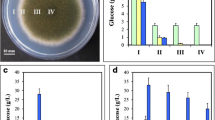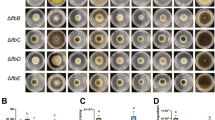Abstract
In terms of cell physiology, autolysis is the centerpiece of carbon-starving fungal cultures. In the filamentous fungus model organism Aspergillus nidulans, the last step of carbon-starvation-triggered autolysis was the degradation of the cell wall of empty hyphae, and this process was independent of concomitantly progressing cell death at the level of regulation. Autolysis-related proteinase and chitinase activities were induced via FluG signaling, which initiates sporulation and inhibits vegetative growth in surface cultures of A. nidulans. Extracellular hydrolase production was also subjected to carbon repression, which was only partly dependent on CreA, the main carbon catabolite repressor in this fungus. These data support the view that one of the main functions of autolysis is supplying nutrients for sporulation, when no other sources of nutrients are available. The divergent regulation of cell death and cell wall degradation provides the fungus with the option to keep dead hyphae intact to help surviving cells to absorb biomaterials from dead neighboring cells before these are released into the extracellular space. The industrial significance of these observations is also discussed in this paper.


Similar content being viewed by others
References
White, S., McIntyre, M., Berry, D. R., & McNeil, B. (2002). Critical Reviews in Biotechnology, 22, 1–14.
McIntyre, M., Berry, D. R., & McNeil, B. (1999). Enzyme and Microbial Technology, 25, 447–454.
Mousavi, S. A., & Robson, G. D. (2003). Fungal Genetics and Biology, 39, 221–229.
Pócsi, I., Pusztahelyi, T., Sámi, L., & Emri, T. (2003). Indian Journal of Biotechnology, 2, 293–301.
Pócsi, I., Molnár, Zs., Pusztahelyi, T., Varecza, Z., & Emri, T. (2007). Acta Biologica Hungarica, 58, 431–440.
Emri, T., Molnár, Zs., Pusztahelyi, T., & Pócsi, I. (2004a). Folia Microbiologica, 49, 277–284.
Tabera, L., Munoz, R., & Gonzalez, R. (2006). Applied and Environmental Microbiology, 72, 2351–2358.
Jimenez-Tobon, G., Kurzatkowski, W., Rozbicka, B., Solecka, J., Pócsi, I., & Penninckx, M. J. (2003). Microbiology, 149, 3121–3127.
Reichard, U., Hung, C. Y., Thomas, P. W., & Cole, G. T. (2000). Infection and Immunity, 68, 5830–5838.
Pócsi, I., Sámi, L., Leiter, É., Majoros, L., Szabó, B., Emri, T., et al. (2001). Acta Microbiologica et Immunologica Hungarica, 48, 533–543.
Thrane, C., Kaufmann, U., Stummann, B. M., & Olsson, S. (2004). Fungal Genetics and Biology, 41, 361–368.
Terakawa, T., Takaya, N., Horiuchi, H., Koike, M., & Takagi, M. (1997). Plant Cell Reports, 16, 439–443.
McNeil, B., Berry, D. R., Harvey, L. M., Grant, A., & White, S. (1998). Biotechnology and Bioengineering, 57, 297–305.
Liu, X. H., Lu, J. P., & Lin, F. C. (2007). Autophagy, 3, 472–473.
Richie, D. L., Fuller, K. K., Fortwendel, J., Miley, M. D., McCarthy, J. W., Feldmesser, M., et al. (2007). Eukaryotic Cell, 6, 2437–2447.
Emri, T., Molnár, Zs., Pusztahelyi, T., Rosén, S., & Pócsi, I. (2004b). Applied Biochemistry and Biotechnology, 118, 337–348.
Emri, T., Molnár, Zs., Pusztahelyi, T., Varecza, Z., & Pócsi, I. (2005a). Mycological Research, 109, 757–763.
Emri, T., Molnár, Zs., & Pócsi, I. (2005b). FEMS Microbiology Letters, 251, 297–303.
Emri, T., Molnár, Zs., Veres, T., Pusztahelyi, T., Dudás, G., & Pócsi, I. (2006). Mycological Research, 110, 1172–1178.
Molnár, Zs., Mészáros, E., Szilágyi, Zs., Rosén, S., Emri, T., & Pócsi, I. (2004). Applied Biochemistry and Biotechnology, 118, 349–360.
Molnár, Zs., Emri, T., Zavaczki, E., Pusztehelyi, T., & Pócsi, I. (2006). Journal of Basic Microbiology, 46, 495–603.
Sándor, E., Pusztahelyi, T., Karaffa, L., Karányi, Zs., Pócsi, I., Biró, S., et al. (1998). FEMS Microbiology Letters, 164, 231–236.
Pócsi, I., Emri, T., Varecza, Z., Sámi, L., & Pusztahelyi, T. (2000). Advances in Chitin Science, 4, 558–564.
Sámi, L., Pusztahelyi, T., Emri, T., Varecza, Z., Fekete, A., Grallert, Á., et al. (2001). Journal of General and Applied Microbiology, 47, 201–211.
Paul, G. C., Kent, C. A., & Thomas, C. R. (1994). Biotechnology and Bioengineering, 44, 655–660.
Jüsten, P., Paul, G. C., Nienow, A. W., & Thomas, C. R. (1998). Biotechnology and Bioengineering, 59, 762–775.
Lee, B. N., & Adams, T. H. (1994a). Molecular Microbiology, 14, 323–334.
Lee, B. N., & Adams, T. H. (1994b). Genes & Development, 8, 641–651.
D’Sousa, C. A., Lee, B. N., & Adams, T. H. (2001). Genetics, 158, 1027–1036.
Adams, T. H., Wieser, J. K., & Yu, J. H. (1998). Microbiology and Molecular Biology Reviews, 62, 35–54.
Seo, J. A., Guan, Y., & Yu, J. H. (2006). Genetics, 172, 1535–1544.
Shroff, R. A., O’Connor, S. M., Hynes, M. J., Lockington, R. A., & Kelly, J. M. (1997). Fungal Genetics and Biology, 22, 28–38.
Nehlin, J. O., & Ronne, H. (1990). EMBO Journal, 9, 2891–2898.
Mathieu, M., & Felenbok, B. (1994). EMBO Journal, 13, 4022–4027.
Shroff, R. A., Lockington, R. A., & Kelly, J. M. (1996). Canadian Journal of Microbiology, 42, 950–959.
Lockington, R. A., & Kelly, J. M. (2001). Molecular Microbiology, 40, 1311–1321.
Skromne, I., Sánchez, O., & Aguirre, J. (1995). Microbiology, 141, 21–28.
Soid-Raggi, G., Sánchez, O., & Aguirre, J. (2006). Molecular Microbiology, 59, 854–869.
Pusztahelyi, T., Pócsi, I., Kozma, J., & Szentirmai, A. (1997). Biotechnology and Applied Biochemistry, 25, 81–86.
Pusztahelyi, T., Molnár, Zs., Emri, T., Klement, É., Miskei, M., Kerékgyártó, J., et al. (2006). Folia Microbiologica, 51, 547–554.
Yamazaki, H., Yamazaki, D., Takaya, N., Takagi, M., Ohta, A., & Horiuchi, H. (2007). Current Genetics, 51, 89–98.
Andrianopoulos, A., & Timberlake, W. E. (1994). Molecular and Cellular Biology, 14, 2503–2515.
Adams, D. J. (2004). Microbiology, 150, 2029–2035.
vanKuyk, P. A., Cheetham, B. F., & Katz, M. E. (2000). Fungal Genetics and Biology, 29, 201–210.
Gronover, C. S., Kasulke, D., Tudzynski, P., & Tudzynski, B. (2001). Molecular Plant-Microbe Interactions, 14, 1293–1302.
Hicks, J. K., Yu, J. H., Keller, N. P., & Adams, T. H. (1997). EMBO Journal, 16, 4916–4923.
Han, K. H., Soe, J. A., & Yu, J. H. (2004). Molecular Microbiology, 53, 529–540.
Yu, J. H. (2006). Journal of Microbiology, 44, 145–154.
Rosén, S., Yu, J. H., & Adams, T. H. (1999). EMBO Journal, 18, 5592–5600.
Seo, J. A., Han, K. H., & Yu, J. H. (2005). Genetics, 171, 81–89.
Katz, M. E., Rice, R. N., & Cheetham, B. F. (1994). Gene, 150, 287–292.
Katz, M. E., Flynn, P. K., vanKuyk, P. A., & Cheetham, B. F. (1996). Molecular & General Genetics, 250, 715–724.
McIntyre, M., Berry, D. R., & McNeil, B. (2000). Applied Microbiology and Biotechnology, 53, 235–242.
Pócsi, I., Prade, R. A., & Pennickx, M. J. (2004). Advances in Microbial Physiology, 49, 1–76.
Leiter, É., Szappanos, H., Oberparleiter, C., Kaiserere, L., Csernoch, L., Pusztahelyi, T., et al. (2005). Antimicrobial Agents and Chemotherapy, 49, 2445–2453.
Marx, F., Binder, U., Leiter, É., and Pócsi, I. (2008). Cellular and Molecular Life Sciences, 65, 445–454.
McIntyre, M., Müller, C., Dynesen, J., & Nielsen, J. (2001). Advances in Biochemical Engineering, Biotechnology, 73, 103–128.
Bartoshevich, Y. E., & Zaslavskaya, P. L. (1984). Mikrobiologiya, 53, 266–270.
Ilmén, M., Thrane, C., & Pentillä, M. (1996). Molecular & General Genetics, 251, 451–460.
Mach, R. L., Strauss, J., Zeilinger, S., Schindler, M., & Kubicek, C. P. (1996). Molecular Microbiology, 21, 1273–1281.
Acknowledgements
The authors are indebted to Prof. Dr. Margaret Katz (University of New England, Armidale, New South Wales, Australia) for providing the MK189 and MK191 strains. One of us (E.T.) was awarded with a Mecenatura Scholarship. I.P. was supported by GENOMNANOTECH-DEBRET (RET-06/2004) and the Öveges József Program of the Hungarian National Office for Research and Technology (grant reference numbers OMFB 01501/2006 and 01528/2006).
Author information
Authors and Affiliations
Corresponding authors
Rights and permissions
About this article
Cite this article
Emri, T., Molnár, Z., Szilágyi, M. et al. Regulation of Autolysis in Aspergillus nidulans . Appl Biochem Biotechnol 151, 211–220 (2008). https://doi.org/10.1007/s12010-008-8174-7
Received:
Accepted:
Published:
Issue Date:
DOI: https://doi.org/10.1007/s12010-008-8174-7




